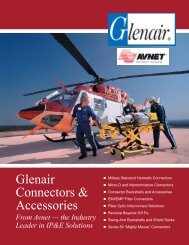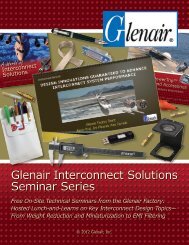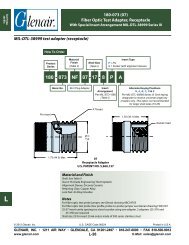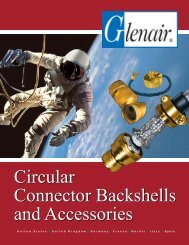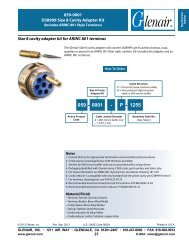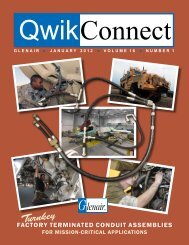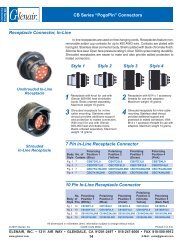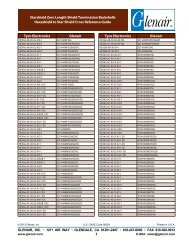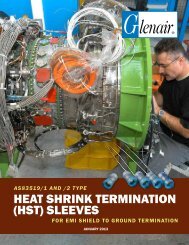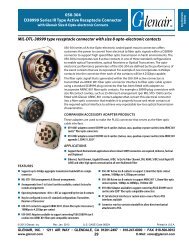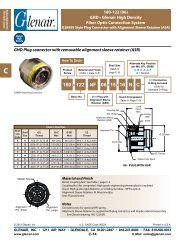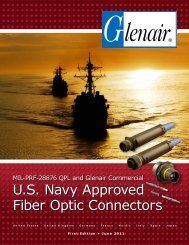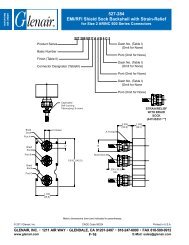April 2007 - Glenair, Inc.
April 2007 - Glenair, Inc.
April 2007 - Glenair, Inc.
Create successful ePaper yourself
Turn your PDF publications into a flip-book with our unique Google optimized e-Paper software.
CoverStory<br />
Special Features and Benefits of the<br />
Composite Swing-Arm EMI/RFI Strain-<br />
Relief Backshell<br />
<strong>Glenair</strong>’s patented composite Swing-Arm<br />
backshell provides lightweight and corrosion-free<br />
strain-relief for wire bundles and open loom cable<br />
assemblies. The shield-sock version of the product<br />
is also appropriate as a strain-relief and shield<br />
termination device for use with shielded, jacketed<br />
cables. When specifi ed with its integrated shieldsock,<br />
the Swing-Arm offers extremely fast and<br />
reliable termination of EMI shields using industrystandard<br />
banding tools and bands.<br />
Made from high-temperature composite<br />
thermoplastic, these rugged assemblies offer easy<br />
installation, long term durability, and outstanding<br />
weight and cost reduction. Standard features<br />
<strong>Glenair</strong> is the industry leader in the innovative use of<br />
thermoplastics in high-reliability interconnect systems.<br />
include self-locking rotatable coupling nuts, and,<br />
on shield-sock versions, a choice of integrated<br />
nickel/copper or metallized thermoplastic EMI/RFI<br />
braiding for electromagnetic compatibility. The<br />
Swing-Arm technology can also be incorporated<br />
into other EMI/RFI shield termination methods such<br />
as standard banding backshells. All versions have<br />
been performance tested to stringent AS85049<br />
mechanical and electrical standards, as well as<br />
individual air frame test regimens, including the F-22.<br />
We mentioned earlier that the Swing-Arm<br />
achieves a stock-keeping economy of three-to-one,<br />
but there is more to the story. EMI/RFI Shield Sock<br />
versions actually achieve an even greater economy<br />
over traditional strain relief systems when cable<br />
entry sizes are considered. Assuming an average of<br />
fi ve cable entry sizes for each of the nine standard<br />
connector shell sizes, stock keeping units (SKUs) for<br />
backshells drop from 135 SKUs (3 angles X 9 shell<br />
sizes X 5 cable entry sizes) to only nine backshell<br />
SKUs and a handful of support rings. This is due to<br />
the Swing-Arm’s design versatility in accommodating<br />
all of the standard cable entry sizes for each<br />
connector shell size.<br />
In addition to standard "click-style" self-locking<br />
rotatable coupling nuts, Swing-Arm is also available<br />
with <strong>Glenair</strong>-patented G-Load Coupling technology.<br />
The coupling nut spins freely without audible detents<br />
and employs a composite wave washer designed<br />
to apply locking pressure as the part is mounted<br />
to the connector. G-Load Coupling is the perfect<br />
solution for applications which require additional<br />
protection against vibration-related decoupling of<br />
the connector-to-backshell termination. Providing<br />
precise axial alignment and seating of interlocking<br />
teeth, the G-Load prevents decoupling even when<br />
backshells are installed with inadequate torque<br />
values. G-Load Couplers meet all MIL-DTL-38999<br />
and AS85049 performance requirements at low<br />
torque: 25 inch pounds for sizes 08-19 and 35 inch<br />
pounds for sizes 20-25.<br />
The original and most popular Swing-<br />
Arm design is made of injection-molded, hightemperature<br />
composite thermoplastic (PEI)<br />
reinforced with a 30% fi ll of glass fi ber. The material<br />
results in a corrosion-free strain relief backshell<br />
which is 40% lighter than aluminum, 80% lighter<br />
than stainless steel, and can endure 2000+ hours<br />
salt spray. In addition to its resistance to corrosion<br />
and galvanic coupling, the thermoplastic material<br />
also provides exceptional vibration dampening and<br />
superior mechanical properties at temperatures<br />
ranging from -65° to +175° C. Fully compatible<br />
with a broad range of materials including other<br />
composites, aluminum, stainless steel, brass and<br />
more, the Swing-Arm base material is compatible<br />
with all standard fi nish treatments such as cadmium<br />
and electroless nickel.<br />
4 QwikConnect <strong>April</strong> <strong>2007</strong>



